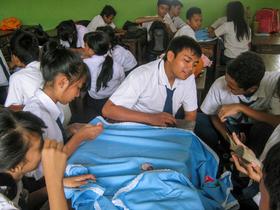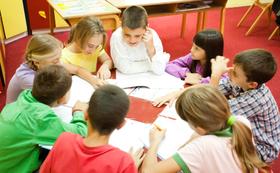Top Rankings
Galloway Township Public School District ranks among the top 20% of public school district in New Jersey for:
Category
Attribute
Diversity
Most diverse schools (Top 1%)
Community Size
Largest student body (number of students) (Top 1%)
For the 2025-26 school year, there are 5 public preschools serving 2,358 students in Galloway Township Public School District. This district's average pre testing ranking is 3/10, which is in the bottom 50% of public pre schools in New Jersey.
Public Preschools in Galloway Township Public School District have an average math proficiency score of 37% (versus the New Jersey public pre school average of 36%), and reading proficiency score of 35% (versus the 44% statewide average).
Minority enrollment is 57% of the student body (majority Hispanic and Black), which is less than the New Jersey public preschool average of 64% (majority Hispanic).
Overview
This School District
This State (NJ)
# Schools
6 Schools
923 Schools
# Students
3,071 Students
368,793 Students
# Teachers
299 Teachers
33,264 Teachers
Student-Teacher Ratio
10:1
10:1
Student By Grade
District Rank
Galloway Township Public School District, which is ranked within the bottom 50% of all 645 school districts in New Jersey (based off of combined math and reading proficiency testing data) for the 2022-2023 school year.
Overall District Rank
#470 out of 648 school districts
(Bottom 50%)
(Bottom 50%)
Math Test Scores (% Proficient)
33%
38%
Reading/Language Arts Test Scores (% Proficient)
32%
49%
Science Test Scores (% Proficient)
18%
23%
Students by Ethnicity:
Diversity Score
0.72
0.71
% American Indian
n/a
n/a
% Asian
10%
8%
% Hispanic
24%
36%
% Black
19%
16%
% White
43%
36%
% Hawaiian
n/a
n/a
% Two or more races
4%
4%
All Ethnic Groups
District Revenue and Spending
The revenue/student of $27,874 is higher than the state median of $26,940. The school district revenue/student has stayed relatively flat over four school years.
The school district's spending/student of $27,748 is higher than the state median of $25,837. The school district spending/student has stayed relatively flat over four school years.
Total Revenue
$86 MM
$36,642 MM
Spending
$85 MM
$35,142 MM
Revenue / Student
$27,874
$26,940
Spending / Student
$27,748
$25,837
Best Galloway Township Public School District Public Preschools (2025-26)
School
(Math and Reading Proficiency)
(Math and Reading Proficiency)
Location
Quick Facts
Rank: #11.
Reeds Road Elementary School
(Math: 37% | Reading: 39%)
Rank:
Rank:
4/
Bottom 50%10
103 South Reeds Road
Absecon, NJ 08205
(609) 748-1250
Absecon, NJ 08205
(609) 748-1250
Gr: PK-6 | 517 students Student-teacher ratio: 9:1 Minority enrollment: 67%
Rank: #22.
Arthur Rann Elementary School
(Math: 39% | Reading: 33%)
Rank:
Rank:
4/
Bottom 50%10
515 S Eighth Ave
Absecon, NJ 08205
(609) 748-1250
Absecon, NJ 08205
(609) 748-1250
Gr: PK-6 | 652 students Student-teacher ratio: 11:1 Minority enrollment: 53%
Rank: #33.
Smithville Elementary School
(Math: 34% | Reading: 38%)
Rank:
Rank:
4/
Bottom 50%10
37 S Old Port Republic Road
Absecon, NJ 08205
(609) 748-1250
Absecon, NJ 08205
(609) 748-1250
Gr: PK-6 | 581 students Student-teacher ratio: 11:1 Minority enrollment: 53%
Rank: #44.
Roland Rogers Elementary School
(Math: 37% | Reading: 31%)
Rank:
Rank:
4/
Bottom 50%10
105 S Reeds Road
Absecon, NJ 08205
(609) 748-1250
Absecon, NJ 08205
(609) 748-1250
Gr: PK-6 | 523 students Student-teacher ratio: 10:1 Minority enrollment: 56%
Rank: n/an/a
400 S Genoa Avenue
Egg Harbor City, NJ 08215
(609) 748-1250
Egg Harbor City, NJ 08215
(609) 748-1250
Gr: PK | 85 students Student-teacher ratio: 7:1 Minority enrollment: 62%
Recent Articles

Charter Schools vs Public Schools 2025: Key Differences & Trends
Explore updated 2025 insights comparing charter schools vs public schools, enrollment, academic outcomes, funding, and real-world examples for families and educators.

Are Public Schools Ready for the 21st Century? 2025 Update
Explore 2025 insights on whether public schools are ready for the 21st century, covering performance, technology, equity, funding, and future-ready learning.

Public School Open House & Enrollment Season Guide
A parent-focused guide to the public school open house and enrollment season, with expert questions, timelines, and decision tips.





